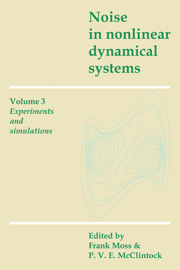Book contents
- Frontmatter
- Contents
- List of contributors
- Preface
- Introduction to Volume 3
- 1 The effects of colored quadratic noise on a turbulent transition in liquid He II
- 2 Electrohydrodynamic instability of nematic liquid crystals: growth process and influence of noise
- 3 Suppression of electrohydrodynamic instabilities by external noise
- 4 Colored noise in dye laser fluctuations
- 5 Noisy dynamics in optically bistable systems
- 6 Use of an electronic model as a guideline in experiments on transient optical bistability
- 7 Computer experiments in non-linear stochastic physics
- 8 Analogue simulations of stochastic processes by means of minimum component electronic devices
- 9 Analogue techniques for the study of problems in stochastic nonlinear dynamics
- Index
5 - Noisy dynamics in optically bistable systems
Published online by Cambridge University Press: 05 January 2012
- Frontmatter
- Contents
- List of contributors
- Preface
- Introduction to Volume 3
- 1 The effects of colored quadratic noise on a turbulent transition in liquid He II
- 2 Electrohydrodynamic instability of nematic liquid crystals: growth process and influence of noise
- 3 Suppression of electrohydrodynamic instabilities by external noise
- 4 Colored noise in dye laser fluctuations
- 5 Noisy dynamics in optically bistable systems
- 6 Use of an electronic model as a guideline in experiments on transient optical bistability
- 7 Computer experiments in non-linear stochastic physics
- 8 Analogue simulations of stochastic processes by means of minimum component electronic devices
- 9 Analogue techniques for the study of problems in stochastic nonlinear dynamics
- Index
Summary
Introduction
Lasers are part of a large class of non-linear systems which covers a great deal of scientific domains, including physics, chemistry, biology, sociology, etc. All these non-linear systems have common properties and present universal features which become more and more extensive as new studies are performed.
In recent years, the interest in these non-linear systems has considerably increased. In particular, it is now well established that the role of fluctuations in non-equilibrium systems is far more relevant than in systems at thermodynamical equilibrium, and the study of their influence on stationary and transient states has become very important.
Among the different aspects presented by the non-linearity in lasers, two of them will be particularly studied here:
(i) The first one is the optical bistability (OB). An optical system is bistable if it has two output states I for the same value of the excitation A over some range of excitation values (see Gibbs, 1985, for a recent review). A typical response curve of such a system is given in Figure 5.1. Here, the system is defined as bistable between A↓ and A↑, where the effectively occupied state depends on the history of the input parameter (see the caption to Figure 5.1). If OB is a common phenomenon in different fields, the OB transient phenomena have far more general features.
- Type
- Chapter
- Information
- Noise in Nonlinear Dynamical Systems , pp. 119 - 158Publisher: Cambridge University PressPrint publication year: 1989
- 1
- Cited by



